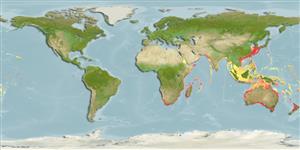Teleostei (teleosts) >
Perciformes/Scorpaenoidei (Scorpionfishes) >
Triglidae (Searobins) > Triglinae
Etymology: Chelidonichthys: Greek, chelidon, -onos = swift, as black as a swift + Greek, ichthys = fish (Ref. 45335).
More on author: Cuvier.
Environment: milieu / climate zone / depth range / distribution range
Ecology
Marine; brackish; demersal; depth range 1 - 200 m (Ref. 4316), usually 75 - 150 m (Ref. 33616). Subtropical; 34°N - 43°S, 15°E - 154°W
Indo-West Pacific: Delagoa Bay, Mozambique to the Cape, South Africa; common in Australia and New Zealand and reported from Japan and Korea. Also reported from Hong Kong (Ref. 12086).
Length at first maturity / Size / Weight / Age
Maturity: Lm 21.2 range ? - ? cm
Max length : 60.0 cm TL male/unsexed; (Ref. 4316); common length : 40.0 cm TL male/unsexed; (Ref. 9258); max. published weight: 1.5 kg (Ref. 9988); max. reported age: 15 years (Ref. 9072)
Found from estuaries to edge of continental shelves over sand and sandy shell seabed (Ref. 9258). Reported to be often found in rivers (Ref. 4316). Juveniles may occur in bays (Ref. 33616). Benthic (Ref. 58302). Dorsal spine reported to be venomous (Ref. 9771). Neither anterolateral glandular grooves nor venom gland is present (Ref. 57406). Current information in the table (dangerous fish) do not match; needs verification. Excellent food fish (Ref. 9771). Utilized fresh and frozen; eaten pan-fried, broiled, microwaved and baked (Ref. 9988).
Life cycle and mating behavior
Maturity | Reproduction | Spawning | Eggs | Fecundity | Larvae
Heemstra, P.C., 1986. Triglidae. p. 486-488. In M.M. Smith and P.C. Heemstra (eds.) Smiths' sea fishes. Springer-Verlag, Berlin. (Ref. 4316)
IUCN Red List Status (Ref. 130435: Version 2024-1)
Human uses
Fisheries: commercial
Tools
Special reports
Download XML
Internet sources
Estimates based on models
Preferred temperature (Ref.
123201): 13.3 - 25, mean 19.3 °C (based on 186 cells).
Phylogenetic diversity index (Ref.
82804): PD
50 = 0.5010 [Uniqueness, from 0.5 = low to 2.0 = high].
Bayesian length-weight: a=0.00776 (0.00407 - 0.01480), b=3.07 (2.90 - 3.24), in cm total length, based on LWR estimates for this species & (Sub)family-body (Ref.
93245).
Trophic level (Ref.
69278): 3.7 ±0.57 se; based on food items.
Generation time: 2.7 (1.9 - 3.0) years. Estimated as median ln(3)/K based on 10
growth studies.
Resilience (Ref.
120179): Medium, minimum population doubling time 1.4 - 4.4 years (K=0.4-0.6; tm=2-3; tmax=15;).
Prior r = 0.36, 95% CL = 0.24 - 0.55, Based on 1 data-limited stock assessment.
Fishing Vulnerability (Ref.
59153): Low to moderate vulnerability (29 of 100).
Climate Vulnerability (Ref.
125649): Moderate to high vulnerability (45 of 100).
Nutrients (Ref.
124155): Calcium = 88.2 [46.4, 215.9] mg/100g; Iron = 1.09 [0.59, 2.04] mg/100g; Protein = 19.3 [18.0, 20.7] %; Omega3 = 0.381 [0.173, 1.076] g/100g; Selenium = 41.3 [20.5, 90.6] μg/100g; VitaminA = 7.38 [2.92, 18.85] μg/100g; Zinc = 0.753 [0.531, 1.080] mg/100g (wet weight); based on
nutrient studies.
